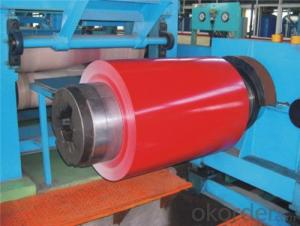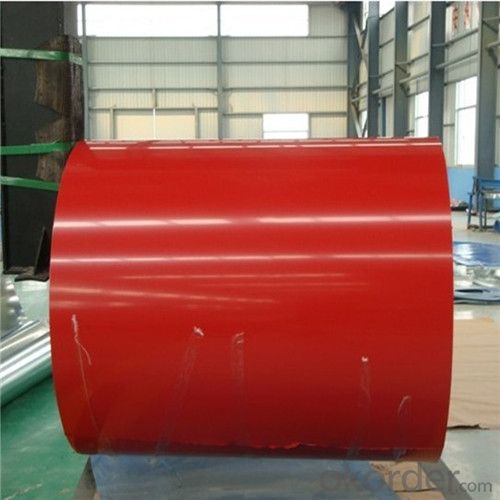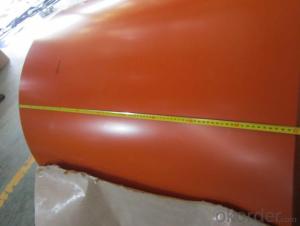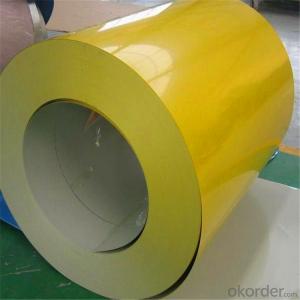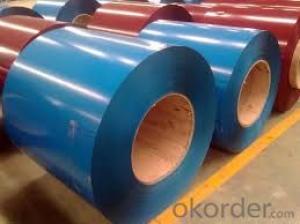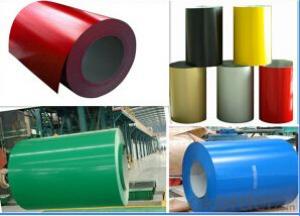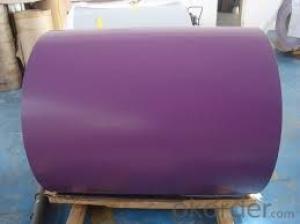Prepainted Galvanized coils of Ppgi Coils
- Loading Port:
- Shanghai
- Payment Terms:
- TT OR LC
- Min Order Qty:
- 25 m.t.
- Supply Capability:
- 30000 m.t./month
OKorder Service Pledge
OKorder Financial Service
You Might Also Like
| 1. | Standard | ASTM,GB,DIN,EN,SUS,JIS,etc | |
| 2. | Material | SGCC,SGCD,SGHC,DC51D,DX51D,DX52D,SPCC,Q235, Q195,Q345 | |
| 3 | Production | Hot rolled,cold rolled | |
| 4. | Specification | Thickness | 0.1mm-6mm |
| Width | 500mm-1500mm | ||
| 5. | Coating material | Oil-based paint,pvc resin paint,natural resin paint,acrylic paint, phenolic resin paint,polyester paint,asphalt paint,epoxy paint,etc. | |
| 6. | Zinc coating | 40g-275g 40g,60g,80g,100g,120g,140g,180g,200g,250g,275g. | |
| 7. | Package | Standard export package. | |
| 8. | Container size | 20ft GP:5898MM(Length)*2352mm(Width)*2393mm(High) 40ft GP:12032mm(Length)*2352mm(Width)*2393mm(High) 40ft HC:12032mm(Length)*2352mm(Width)*2393mm(High) | |
| 9. | Price item | EXW,FOB,CIF,CFR,CNF,etc. | |
| 10. | Export to | America,Australia,Brazil,Canada,Iran,India,Turkey,Peru, Thailand,United Kingdom,etc. | |
| 11. | Quality Control | Mill test certificate is supplied with shipment, Third part inspection is acceptable. | |
| 12. | Delivery | Normally according to the order quantity or upon negotiation. | |
| 13. | Contact | If you have any question,please feel free to contact me. | |
· ISO System
· SGS and BV Audited company .
· Industry experience over 20 years.
· Management Systems-Internal Software
· Finished Product Inventory-More Than 500 Tons.
· Raw Material inventory -Over 800 Mertic Tons.
· Shipment of goods -More than 30 countries worldwide.
· We have the most convenient transport and prompt delivery.
· We offer competitive price with best service .
· We have high technical production line with top quality products.
· We have win high reputation based on best quality products.
- Q: Are Danielle steel books good to read. Im 15 , but do I have to wait until Im a bit older.
- I love her books, and your ok. Read one now, you'll love it.
- Q: i have been playing with hand me down graphite shaft irons and wedges. i was wondering if someone of my stature (5'3, 90 lbs., 12 years old) should be using steel shafted irons. i can definately swing them im just wondering if they are better for making contact
- As long as the clubs you have now fit you, you should stick with those. You are going to be growing alot in the next few years, so once your current clubs are too small, then by all means feel free to go to steel shafts.
- Q: How are steel coils recycled?
- Steel coils are recycled by first being collected and transported to a recycling facility. They are then processed to remove any impurities or contaminants, such as coatings or oils. The coils are then shredded into smaller pieces and melted down in a furnace. The molten steel is then molded into new coils or other steel products, ready to be used again in manufacturing processes.
- Q: What are the common surface defects found in steel coils?
- Some common surface defects found in steel coils include rust, scratches, dents, pits, and mill scale.
- Q: How are steel coils processed and shaped for specific applications?
- Steel coils are processed and shaped for specific applications through a series of steps. First, the coils are uncoiled and flattened to remove any bends or curls. Then, they undergo various processes such as cutting, slitting, or shearing to achieve the desired dimensions. Next, the steel is often subjected to heat treatment, such as annealing or tempering, to enhance its strength and flexibility. Finally, the steel is shaped into specific forms using techniques like rolling, bending, or stamping, to meet the requirements of different applications ranging from automotive parts to construction materials.
- Q: How are steel coils used in the production of heating and cooling systems?
- Steel coils are used in the production of heating and cooling systems as they serve as the primary component for heat transfer. These coils are designed to efficiently transfer heat or cool air, allowing for the effective regulation of temperature in heating and cooling systems.
- Q: What is the maximum load capacity for steel coil storage racks?
- The maximum load capacity for steel coil storage racks can vary depending on various factors such as the design, dimensions, and specifications of the rack. It is recommended to consult the manufacturer or supplier for the specific load capacity of the steel coil storage rack you are using.
- Q: hey i was looking to buy a khukuri machete by cas iberia. its made of carbon steel but doesnt say which one. anyone that is into knives and all that know how this would hold up and the rust resistance of it? mostly be used for cutting bush and small trees
- There's no way to tell from the information you posted. Given it's for a machete I would guess it would be a fairly high carbon steel. Rust resistance will be relatively poor. It will last for years though as long as you clean and dry it after use.
- Q: What are the different surface treatments for steel coils?
- There are several different surface treatments available for steel coils, depending on the desired outcome and application. Some of the most common surface treatments for steel coils include: 1. Hot-dip galvanizing: This process involves immersing the steel coils in a bath of molten zinc, which forms a protective layer on the surface of the steel. Hot-dip galvanizing provides excellent corrosion resistance and is often used for outdoor applications. 2. Electro-galvanizing: Similar to hot-dip galvanizing, but instead of immersing the steel coils in molten zinc, a thin layer of zinc is electroplated onto the surface of the steel. Electro-galvanizing provides good corrosion resistance and is commonly used for indoor applications. 3. Powder coating: This process involves applying a dry powder to the surface of the steel coils, which is then heated and cured to form a hard, durable coating. Powder coating provides excellent corrosion resistance and is available in a wide range of colors and finishes. 4. Paint coating: Steel coils can also be coated with a liquid paint, which provides both corrosion resistance and aesthetic appeal. Paint coatings can be applied in various thicknesses and finishes, depending on the desired look and level of protection required. 5. Phosphating: Phosphating is a chemical treatment that involves immersing the steel coils in a phosphate solution. This process creates a thin, adherent layer of phosphate on the surface of the steel, which enhances paint adhesion and improves corrosion resistance. 6. Chromate conversion coating: Also known as chromating or passivation, this process involves immersing the steel coils in a solution containing chromium salts. Chromate conversion coatings provide excellent corrosion resistance and also act as a primer for subsequent paint or powder coating. 7. Zinc-nickel plating: This surface treatment involves electroplating a layer of zinc-nickel alloy onto the steel coils. Zinc-nickel plating provides superior corrosion resistance compared to pure zinc plating and is often used in demanding environments. These are just a few of the many surface treatments available for steel coils. The choice of treatment depends on factors such as the application, desired level of corrosion resistance, aesthetic requirements, and budget. It is important to carefully consider the specific needs of the project and consult with experts to determine the most suitable surface treatment for steel coils.
- Q: What are the common coil sizes available for steel coils?
- The common coil sizes available for steel coils vary, but some standard sizes include 36 inches, 48 inches, and 60 inches in width, with coil lengths ranging from 1000 feet to 5000 feet. However, it is important to note that coil sizes can be customized according to specific requirements and applications.
Send your message to us
Prepainted Galvanized coils of Ppgi Coils
- Loading Port:
- Shanghai
- Payment Terms:
- TT OR LC
- Min Order Qty:
- 25 m.t.
- Supply Capability:
- 30000 m.t./month
OKorder Service Pledge
OKorder Financial Service
Similar products
Hot products
Hot Searches
Related keywords
